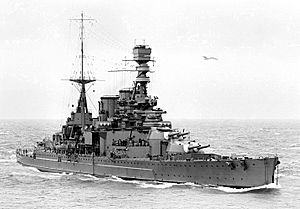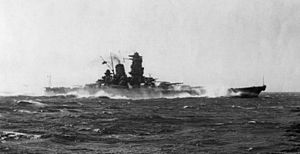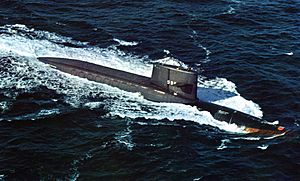Capital ship facts for kids
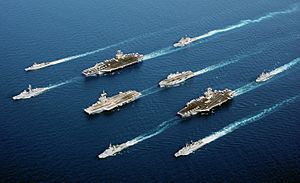
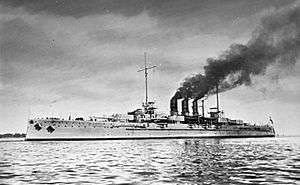
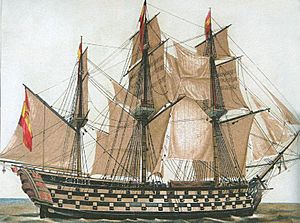
The capital ships of a navy are its most important warships. They are usually the largest ships in a fleet. A capital ship is often the main or leading ship in a naval fleet.
Contents
Why Capital Ships Are Important
There isn't one strict rule for what makes a capital ship. But it's a helpful idea in planning how navies fight. For example, it lets people compare how strong different navies are. They don't need to look at every small detail like ship size or gun types.
A famous idea called the Mahanian doctrine said that a strong navy needs many capital ships. This idea was used when planning the defense of Singapore in World War II. The Royal Navy had to decide where to send its battleships. Should they go to the Atlantic Ocean or the Pacific Ocean?
The Imperial Japanese Navy also used this idea. It led them to attack Pearl Harbor. They wanted to destroy the battleships of the U.S. Pacific Fleet. The war in the Pacific Ocean was mostly fought at sea. So, the United States Navy sent most of its battleships and aircraft carriers there. The war in Europe was mostly on land. Germany's surface fleet was small. The ships used in the Battle of the Atlantic were mostly destroyers. They fought against German U-boats (submarines).
Capital Ships in the Age of Sail
Before steel ships were invented, a capital ship was a "ship of the line." These were the biggest sailing warships. The Royal Navy had a system to rate them by the number of guns they carried:
- First Rate: These ships had 100 or more guns. They usually carried them on three or four decks. Ships with four decks had trouble in rough seas. Their lowest guns could rarely fire unless the water was calm.
- Second Rate: These ships had 90 to 98 guns.
- Third Rate: These ships had 64 to 80 guns. The 64-gun ships were smaller and not very common.
- Fourth Rate: These ships had 46 to 60 guns. By 1756, these ships were too weak to fight in the main battle line. They were used for other jobs. They also served in shallow waters like the North Sea. Larger ships of the line could not sail there.
Frigates were smaller ships. They were called "fifth rate" ships. Even smaller ships like corvettes were "sixth rate." Later, some larger frigates were called "fourth rate" ships. This happened near the end of the Napoleonic Wars.
Battleships and Battlecruisers
The term "capital ship" was first used in 1909. It was officially defined in naval treaties in the 1920s and 1930s. These treaties included the 1922 Washington Naval Treaty. This term mostly applied to ships built after the dreadnought revolution. These were the dreadnought battleships and battlecruisers.
In the 20th century, especially during World War I and World War II, typical capital ships were battleships and battlecruisers. These ships were usually very large, weighing over 20,000 tons. They had very big guns and thick armor.
Cruisers were important ships, but they were not usually called capital ships. One exception in World War II was the German Deutschland-class cruiser class. These ships were like heavy cruisers but had much bigger guns. Some people called them "Pocket battleships." This was because they were some of the few large warships the German Kriegsmarine had.
During the Cold War, the Soviet Kirov-class class missile cruisers were very big. They were as large as some World War II battleships. Some people thought they might be a new type of capital ship. But in design, the Kirov is a very large guided-missile cruiser. It uses nuclear power.
Aircraft Carriers

By late 1942, aircraft carriers were widely seen as capital ships. Only large fleet carriers were considered capital ships. Smaller "light carriers" and "escort carriers" were not. The U.S. Navy had to rely mostly on its aircraft carriers. This happened after the attack on Pearl Harbor damaged or sank many of its battleships.
Today, in the 21st century, the aircraft carrier is the only remaining type of capital ship. Their power is measured by how many aircraft they can carry. The United States has the most aircraft carriers. It has 11 active supercarriers. Each can carry almost 100 airplanes. It also has nine amphibious assault ships. These ships can act like smaller aircraft carriers.
Ballistic Missile Submarines
Ballistic missile submarines, also called "boomers," are very important ships. They are similar in size to early battleships. But they are usually part of a country's nuclear deterrent force. This means they carry nuclear missiles to prevent attacks. They do not have the same job as traditional capital ships, which is to control the seas.
However, some navies, like the Royal Navy and the United States Navy, do consider these submarines to be capital ships. They have even given some of them names that were once used for battleships. Examples include Dreadnought and Vanguard.
Naming Capital Ships
Some navies save special names for their capital ships. These names might be for leaders (like the German Bismarck). They could also be for important places, famous naval officers (like De Ruyter), or historical events (like USS Constitution). Sometimes, they use traditional names (like HMS Ark Royal).
Starting with USS Texas, the first U.S. battleship, U.S. capital ships were usually named after U.S. states. Cruisers were often named after U.S. territories or cities. Before and during World War II, the Imperial Japanese Navy also named its battleships after provinces (like Yamato).
Even though aircraft carriers are very important today, the U.S. Navy has never named them after U.S. states. Today, U.S. aircraft carriers are usually named after politicians or people famous in U.S. naval history. Examples include Gerald R. Ford and Chester W. Nimitz. The only exception is Enterprise.
Starting with the first class of Trident missile submarines (the Ohio class class), U.S. nuclear submarines began to be named after states. Before this, ballistic missile submarines were not named for states. After the last Ohio-class submarine was built, state names were also used for attack submarines (like the Virginia class class). Earlier attack submarines were usually named after sea animals or cities.
See also
 In Spanish: Buque capital para niños
In Spanish: Buque capital para niños
- Ship of the line
- Flagship
- Dreadnought
- Battleship
- Battlecruiser
- Aircraft carrier
- Nuclear submarine
- List of sunken battleships
- List of sunken battlecruisers
- List of sunken aircraft carriers
- List of sunken nuclear submarines


